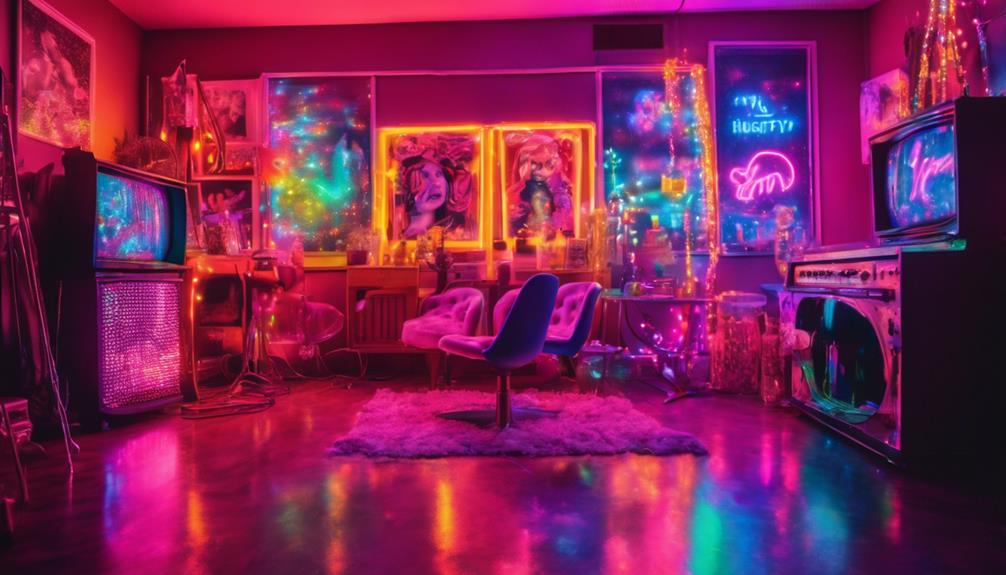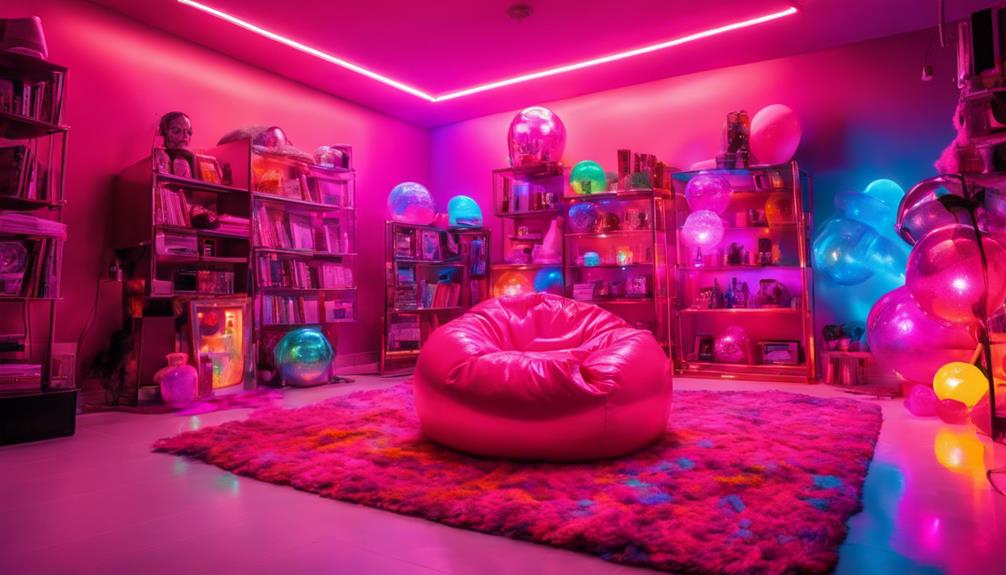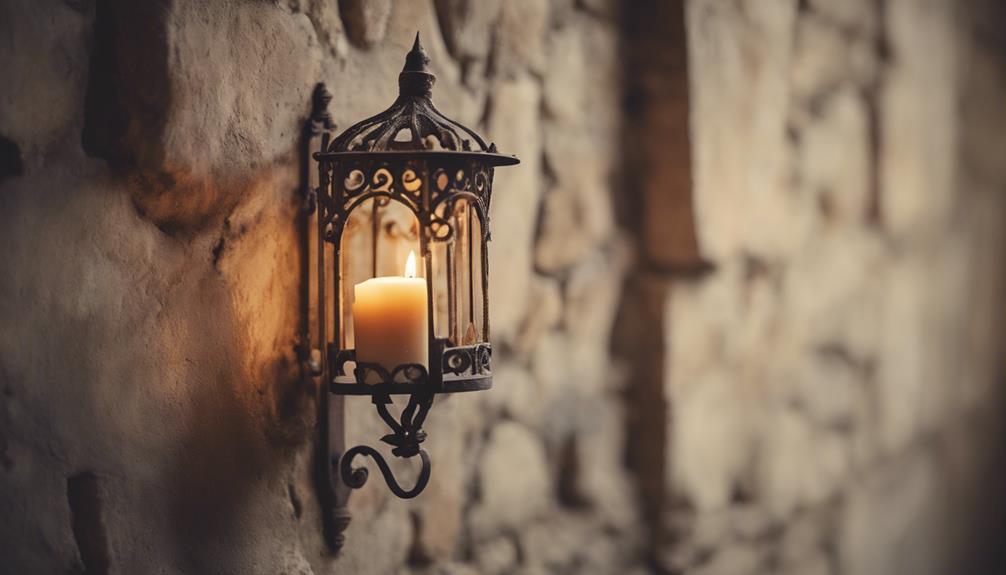To create a Y2K room that wows, infuse vibrant hues like pinks and blues with metallic accents for a futuristic vibe. Incorporate bold patterns in your textiles, like plush velvet cushions and funky rugs. Add statement lighting with neon LED strips or a disco ball pendant to set the mood. Don't forget playful decor, like glittery star wall stickers and iridescent beaded curtains, which add charm and nostalgia. Finally, consider funky flooring options, like retro-patterned vinyl or checkerboard tiles, to elevate your space. Curious about more ways to capture that Y2K spirit? There's plenty to explore!
Key Elements

When you're planning your Y2K room decor, the color scheme sets the tone for the entire space.
You'll want to mix vibrant materials and textures to create a playful yet cohesive look.
Keep in mind that every element, from your walls to your accessories, contributes to that nostalgic vibe you're aiming for.
Color Scheme
Y2K room decor thrives on a vibrant color scheme that combines daring hues with metallic accents, creating an energetic and futuristic atmosphere.
To transform your Y2K bedroom, think of vivid pinks, blues, and yellows that grab attention and establish a lively vibe. Don't shy away from incorporating metallics like silver and gold; they enhance the space's futuristic essence while adding a touch of glam.
Bold patterns—such as polka dots, stripes, and animal prints—are essential for achieving that playful, eclectic look. Mix and match these designs to create an enthralling visual experience that reflects the boldness of the era. You can also play with textures like velvet, faux fur, and glitter to add depth and warmth to your Y2K bedroom.
Recent trends have introduced more natural colors, like green and orange, into the mix, offering a revitalizing twist. However, neon shades still reign supreme, bridging the nostalgic and contemporary styles seamlessly.
Embrace this lively color palette and let your creativity flow; it'll make your Y2K bedroom a standout space that wows everyone who enters!
Materials
To fully embrace the vibrant color schemes of the Y2K era, incorporating unique materials like velvet, faux fur, and glitter can elevate your room's decor and create a dynamic visual experience.
Velvet, with its rich texture and bold hues, adds a luxurious touch that perfectly complements the playful aesthetic of Y2K Room Decor. Opt for velvet cushions or an eye-catching sofa to set the tone.
Faux fur is another essential material, bringing warmth and comfort while maintaining a fun vibe. Consider adding faux fur throws or a shaggy rug to enhance coziness and make your space inviting.
Don't forget about glitter! Whether it's in wall art, decorative accents, or light fixtures, a sprinkle of glitter can elevate the whimsical feel of your room.
Metallic finishes in furniture can also evoke that retro-futuristic charm. Think shiny silver or gold decor items that reflect light and add a modern twist.
Textures
Incorporating a variety of textures is essential for achieving the playful and eclectic vibe that defines Y2K room decor. Start with plush velvet cushions and faux fur throws to create a cozy atmosphere. Layering these soft textiles with bold patterned rugs, like polka dots or stripes, helps establish visual interest. Don't forget about soft carpets and shaggy rugs that add comfort, especially underfoot.
To balance the softness, consider sleek wood or tile floors for a contemporary touch. Metallic textures, particularly in silver and gold, can really enhance the vibrant color palettes typical of Y2K decor. Look for shiny surfaces in furniture or accessories that catch the light and draw the eye.
Additionally, incorporate transparent and iridescent materials, like acrylic furniture or holographic accessories, for that whimsical, futuristic feel. A plush bean bag chair can serve as both a stylish and functional addition, inviting relaxation while echoing the nostalgic vibe of the era.
Essential Fixtures and Furniture

When it comes to essential fixtures and furniture for your Y2K room, think fun and functionality.
A glittery bean bag chair and a faux fur accent chair not only add comfort but also a playful vibe.
Don't forget glow-in-the-dark star decals to create a dreamy atmosphere that captures the spirit of the era.
Glittery Bean Bag Chair
A Glittery Bean Bag Chair adds a playful touch to your space while offering the ultimate comfort for lounging or chilling out. This quintessential piece of Y2K decor combines a fun aesthetic with plush filling, making it perfect for cozy corners or casual hangouts. The shimmering fabric reflects vibrant colors, instantly catching the eye and becoming a focal point in any room.
Available in various sizes and colors, you can easily find a glittery bean bag chair that suits your style and fits your space. With prices ranging from $30 to $100, it's an affordable yet stylish addition to your decor. Plus, many options come with removable and washable covers, ensuring that maintenance is a breeze while keeping the sparkle intact.
Whether you're binge-watching your favorite show, reading, or just hanging out with friends, this chair provides the comfort you need. The fun element of the glittery bean bag chair captures the essence of early 2000s nostalgia, making it a trendy choice that'll wow everyone who enters your space.
Embrace this playful vibe and transform your room with a touch of nostalgia!
Faux Fur Accent Chair
Faux fur accent chairs instantly elevate your Y2K room decor with their luxurious feel and vibrant colors, creating a cozy yet stylish seating option. These chairs are perfect for adding a touch of comfort while embracing the bold aesthetics of the early 2000s. You'll often find them in eye-catching hues like hot pink or electric blue, which align beautifully with the maximalist style of that era.
Not only do faux fur accent chairs provide a plush place to sit, but they also contribute to the layered textures that are essential in Y2K decor. Pair them with velvet cushions or glittery throws to enhance that nostalgic vibe. With unique shapes and retro-inspired silhouettes, these chairs serve as statement pieces, drawing attention and becoming focal points in your space.
Prices for faux fur accent chairs typically range from $100 to $300, making it easy to find one that fits your budget while still achieving that trendy look.
Glow-In-The-Dark Star Decals
Adding glow-in-the-dark star decals to your Y2K room decor creates a whimsical atmosphere, transforming your ceiling into a dreamy night sky that sparks nostalgia and imagination. These decals are a fantastic choice for anyone looking to add a playful touch to their space. Available in various sizes and colors, they often feature classic shapes like stars and moons, enhancing the fun vibe of your room.
One of the best things about glow-in-the-dark star decals is their renter-friendly nature. You can easily apply and remove them without damaging your walls or ceilings, making them perfect for temporary spaces. Plus, many designs are made from non-toxic materials, ensuring they're safe for children's rooms or play areas while still appealing to all ages.
When exposed to light, these decals glow for several hours, providing a soothing ambiance that promotes relaxation and creativity. Imagine winding down after a long day under a twinkling sky!
Lighting Ideas

When it comes to lighting in your Y2K-inspired room, you can really amp up the vibe with neon LED strip lighting and color-changing floor lamps.
Think about adding a disco ball pendant light to create that iconic party atmosphere, or a retro lava lamp for a nostalgic touch.
These lighting ideas not only enhance the aesthetic but also set the perfect mood for any occasion.
Neon LED Strip Lighting
Neon LED strip lighting transforms any Y2K-inspired room with its vibrant colors and customizable features, instantly elevating the space's energy and style. You can easily install these versatile strips along walls, ceilings, or furniture, creating a dynamic atmosphere that reflects the eclectic aesthetic of the era.
With adjustable brightness and color-changing options, you can effortlessly set the mood for various occasions, whether you're hosting a party or enjoying a quiet night in. Installation is a breeze, thanks to the adhesive backing that allows you to achieve a professional look without complicated setups.
Plus, you'll appreciate that neon LED strip lighting is energy-efficient and long-lasting, helping you enhance your room's visual appeal while keeping electricity costs down compared to traditional lighting options.
Don't hesitate to mix and match colors to create unique combinations that resonate with your personal style. By incorporating neon LED strip lighting, you're not just decorating; you're making a statement that captures the essence of Y2K nostalgia while remaining trendy and fresh.
Elevate your decor game and let your space shine with these eye-catching strips!
Color-Changing LED Floor Lamps
Color-changing LED floor lamps bring a playful energy to your Y2K room decor, allowing you to easily switch up the ambiance with vibrant hues that reflect your unique style. These lamps offer a wide spectrum of colors, from neon pinks and blues to vivid greens and purples, making it simple to create a personalized atmosphere that complements your bold decor choices.
With many color-changing LED floor lamps featuring remote controls or smart technology, you can effortlessly adjust settings to match your mood or even sync the lighting with your favorite tunes for a party-ready vibe. They serve as eye-catching statement pieces, available in designs ranging from sleek and modern to charmingly retro, fitting seamlessly into the eclectic Y2K aesthetic.
Plus, energy-efficient LED technology guarantees you're not just lighting up your space stylishly, but also practically, as these lamps provide long-lasting illumination while keeping electricity costs down.
Whether you want to create a chill vibe for relaxation or an energetic atmosphere for gatherings, color-changing LED floor lamps are a must-have addition to your Y2K-inspired room.
Disco Ball Pendant Light
A disco ball pendant light instantly transforms your space into a lively party atmosphere, reflecting vibrant patterns that echo the early 2000s vibe. These eye-catching fixtures serve as striking centerpieces, radiating energy and fun.
You'll find disco balls available in various sizes and styles, making them versatile decor choices that complement both modern and retro aesthetics in your Y2K-inspired room. When you incorporate a disco ball pendant light, you enhance the overall lighting experience, especially when paired with other trendy fixtures like neon lights and LED strips.
The combination of mirrored surfaces and metallic finishes adds a touch of glamour, fitting seamlessly into maximalist decor themes. To elevate your space even further, consider hanging multiple disco ball pendant lights at varying heights. This creates a dynamic visual display, layering light and adding depth.
Whether you're hosting a gathering or simply relaxing at home, a disco ball will evoke nostalgia while keeping your space trendy and fun. So, if you want to wow everyone who steps into your room, a disco ball pendant light is the perfect addition!
Retro Lava Lamp Accent
Transform your space with a retro lava lamp accent, bringing a whimsical and nostalgic vibe that perfectly complements your Y2K decor. These enchanting lamps, popularized in the 1960s and '70s, feature mesmerizing, flowing wax patterns that instantly draw the eye.
You'll love how their bright and bold hues align with the maximalist aesthetic of the early 2000s, making them a standout feature in any room.
To create the ideal mood lighting, a classic psychedelic retro lava lamp typically requires a 40-watt bulb to heat the wax. This setup allows the wax to flow, producing a stunning visual effect that enhances your space.
If you're looking for energy-efficient options, consider modern variations that incorporate LED technology while still maintaining that iconic retro look.
Decorative Elements

To truly capture the essence of Y2K decor, you can start by adding a beaded curtain with iridescent colors that catches the light beautifully.
Glittery star wall stickers and a moon phase wall hanging can enhance the whimsical vibe of your space, bringing a touch of nostalgia.
These decorative elements not only add style but also create a playful atmosphere that reflects the fun spirit of the era.
Beaded Curtain With Iridescent Colors
Beaded curtains with iridescent colors instantly elevate your Y2K room decor, adding a playful and whimsical touch that draws the eye. These vibrant curtains feature colorful beads that reflect light beautifully, creating a stunning visual effect that enhances your room's overall ambiance.
Whether you use them to separate spaces or add a bit of privacy without blocking light, beaded curtains are both functional and stylish. Lightweight and easy to install, these iridescent curtains can be placed at doorways or used as decorative room dividers. They complement other Y2K decor elements like neon lighting and retro furniture, helping you create a cohesive aesthetic.
With a variety of color combinations available, you can easily customize your beaded curtains to match your specific themes or personal style. Imagine the shimmering effect these iridescent colors create as they catch the light, adding depth and dimension to your space.
Incorporating beaded curtains into your Y2K room decor not only enhances the playful vibe but also invites a sense of nostalgia that'll wow everyone who steps inside your room.
Glittery Star Wall Stickers
Glittery star wall stickers instantly add a whimsical and nostalgic touch to your Y2K room decor, bringing back the playful vibes of the late '90s and early 2000s. Available in various sizes and colors, these stickers let you create eye-catching focal points on your walls, ceilings, or furniture. This versatility allows for personal expression and creativity in your decor choices.
One of the best features of glittery star wall stickers is that many are made from removable vinyl. This means you can easily apply and reposition them without damaging your walls, making them perfect for renters or those who like to change their decor frequently. Plus, the shimmering effect of these stickers beautifully complements other key elements of Y2K aesthetics, like neon lights and psychedelic patterns, helping to create a cohesive and vibrant atmosphere in your space.
With retail prices typically ranging from $10 to $30, glittery star wall stickers are an affordable and fun option to refresh your room with a nostalgic flair. So go ahead, let your creativity shine and transform your space into a dazzling tribute to the Y2K era!
Glittery Moon Phase Wall Hanging
A stunning Glittery Moon Phase Wall Hanging captures the ethereal beauty of the lunar cycle, making it an ideal accent for your Y2K room decor. This eye-catching piece is typically crafted from sequins or reflective materials, bringing a splash of sparkle and whimsy that enhances the nostalgic vibe of the early 2000s.
With options available in various sizes and color combinations, you can easily find a wall hanging that fits your unique style, whether you lean towards vibrant neons or softer pastels. The intricate design often includes detailed representations of each moon phase, adding an educational element for those fascinated by lunar cycles.
Incorporating a Glittery Moon Phase Wall Hanging into your space can transform it into a dreamy atmosphere, especially when paired with ambient lighting like fairy lights or neon accents. This decorative element not only elevates your room's aesthetic but also embodies those Y2K dreams that many of us cherish.
Flooring

When it comes to flooring in your Y2K-inspired room, you've got some fun options to contemplate.
A shaggy area rug in pastel can add a cozy touch, while vinyl plank with retro patterns brings a playful vibe.
You might also want to reflect on checkerboard tiles in bright colors to really capture that bold aesthetic.
Shaggy Area Rug in Pastel
Transform your space with a soft, pastel shaggy area rug that adds both comfort and style, perfectly capturing the essence of Y2K decor. These pastel shag rugs, featuring delightful hues like pink, mint green, and lavender, bring a cozy, inviting touch to your room. They align seamlessly with the vibrant color palettes of the early 2000s, making them a fabulous choice for any nostalgic aesthetic.
The plush texture of a shag rug not only feels great underfoot but also enhances the layered, maximalist look favored in Y2K design. Regardless of your room's size, you can find a shaggy area rug that fits perfectly, whether you're looking to fill a cozy nook or a larger living area.
To keep your pastel shag rugs looking fabulous, regular vacuuming is key. This simple maintenance task guarantees your rug retains its fluffy appearance and continues to be a stylish focal point in your space.
With its soft colors and inviting texture, a pastel shag rug is an easy way to elevate your Y2K-themed room and create an atmosphere that wows everyone who steps inside.
Vinyl Plank With Retro Patterns
Vinyl plank flooring with retro patterns instantly injects bold, nostalgic vibes into your Y2K-themed room, making it a stylish choice for anyone looking to embrace the era's playful aesthetics. Featuring designs like polka dots and stripes in vibrant colors, this flooring captures the essence of the early 2000s.
Not only does vinyl plank flooring offer a fun look, but it's also durable and often water-resistant, making it perfect for high-traffic areas. Many options come with cushioned backing, adding comfort underfoot and enhancing your space's coziness.
Installation is a breeze! You can find peel-and-stick or click-lock designs that let you transform your room quickly. This ease means you won't waste time on complicated renovations.
To create a layered, dynamic visual experience, pair retro-patterned vinyl planks with eclectic decor, like shag rugs and bold wall art. The combination of textures and styles will wow everyone who steps into your room.
With vinyl plank flooring, you can effortlessly achieve that distinct Y2K flair while keeping practicality in mind.
Checkerboard Tile in Bright Colors
Brightly colored checkerboard tile flooring instantly brings a playful and energetic vibe to your Y2K-inspired space. Think electric blue, hot pink, and neon green—these bold hues capture the essence of early 2000s decor and make a striking statement in any room. This dynamic flooring style enhances the maximalist aesthetic that defines Y2K interiors, creating a unique visual effect that draws the eye.
You can easily pair checkerboard tile with other vibrant decor elements, like retro furniture and eclectic accessories, to create a cohesive look that screams nostalgia. Opting for glossy or iridescent finishes on your checkerboard tiles can elevate the nostalgic feel, reflecting the shiny, futuristic trends of the era.
Versatile and easy to maintain, bright checkerboard tiles can transform various spaces in your home, from bedrooms to game rooms or even kitchens. They evoke a fun and inviting atmosphere that encourages creativity and playfulness.
Conclusion
Incorporating Y2K room decor into your space is a fun way to blend nostalgia with modern style.
By mixing essential furniture, vibrant lighting, and quirky decorative elements, you can create an environment that truly reflects your personality.
Don't forget to pay attention to your flooring, as it can tie the whole look together.
Embrace the playful spirit of the early 2000s and watch as your room transforms into a trendy haven that'll wow everyone who visits!









